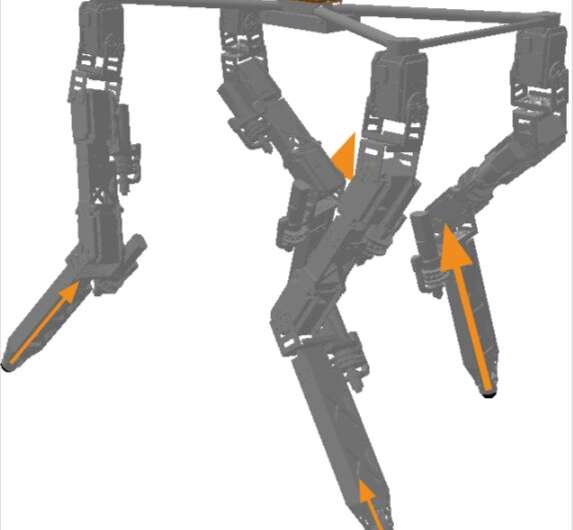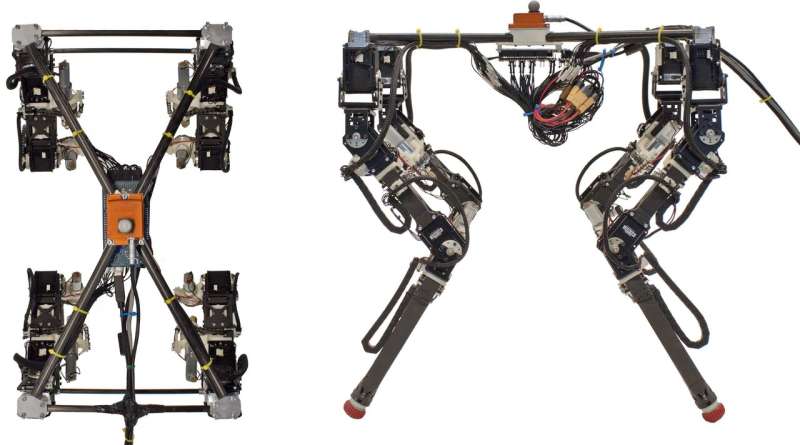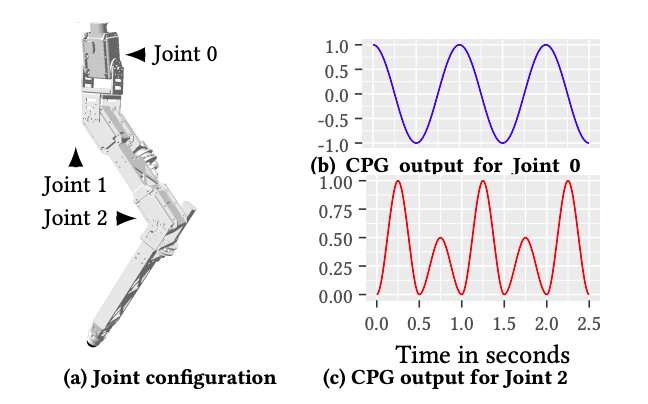April 16, 2019 feature
A new method to enable robust locomotion in a quadruped robot

One of the key challenges for robotics research is the development of effective and resilient control systems, which allow robots to navigate a variety of environments and deal with unexpected events. Researchers at the University of Oslo have recently developed an evolved embodied phase coordination technique for robust quadruped robot locomotion. Their work, published on arXiv, was partly sponsored by the Research Council of Norway.
"The motivating factor for us was the observation that some robot behaviors that we trained in simulation did not function properly when tested on the real robot," Jørgen Nordmoen, one of the researchers involved in the study, told TechXplore. "This observation is a known challenge, often called 'the reality gap,' and we wanted to see if using sensor data could help to overcome this challenge."
To effectively reduce the 'reality gap' that is often observed in robotics studies, Nordmoen and his colleagues wanted to combine central pattern generators (CPGs) with feedback from the robot's body and sensors. CPGs are a popular method for generating rhythmic undulations or motor patterns in robots, which can be used as the underpinning of movement. Artificial CPGs are inspired by the spinal cords of animals, which are known to contain neurons that generate rhythmic signals in the absence of sensory information.
"CPGs are relatively straightforward to train, however, they do not by themselves incorporate any information about the outside world," Nordmoen said. "Our main objectives were to see if we could successfully combine a complex CPG network with embodied phase coordination and if the incorporation of sensor data could improve how the robot behaved in the real world."

Embodied phase coordination techniques work by sensing the amount of pressure placed by the robot in each of its feet, using this measurement to control the synchronization of its legs. In their study, the researchers employed a minimalistic approach called TEGOTAE, which uses sensor feedback for emergent phase-coupling between the robot's legs.
Usually, in legged robots, each leg is explicitly coordinated with the others, meaning that a leg always know the relative position of other legs. In contrast, in the embodied phase coordination approach devised by Nordmoen and his colleagues, each leg is decoupled from the others and the body itself implicitly enforces the synchronization between legs. The foot pressure sensor added by the researchers enables implicit synchronization, ultimately enhancing the robot's coordination.
"Our method uses a more complex CPG than other approaches, utilizing embodied phase coordination and performing the experiments on a more complex robot," Nordmoen said. "In addition, we trained the CPG using an evolutionary optimization algorithm, which together with the embodied phase coordination allows the walking rhythm to automatically adapt to the robot and environment."

In their study, the researchers applied their method to DyRET, a four-legged robot with a mammalian morphology. They first trained the quadruped robot in simulations, and subsequently transferred their tests to the real world to verify whether the training was effective. This allowed them to evaluate their technique before applying it in real-world scenarios without causing damage to the robot.
"Practically speaking, our work could lead to legged robots that are better at adapting to their surroundings, thus handling different environments," Nordmoen said. "This includes facilitating the transfer of robot controllers from simulation to the real world. As we wrote in the paper, legged robots have the possibility of aiding on the user's terms with little in the way of adjustment needed from the user compared to wheeled robots."
The technique devised by Nordmoen and his colleagues could facilitate the development of robots with more robust locomotion skills. In the future, other researchers could integrate the approach into their robots or draw inspiration from this study to develop similar techniques. According to Nordmoen, the difficulties associated with integrating sensor feedback in legged robots and the simplicity of this new embodied phase coordination approach could be a great starting point for future research.
"We are currently working on better understanding the mechanism that underlies embodied phase coordination," he added. "This will hopefully allow us to improve the concept and generate better movement strategies. In addition, we would like to see how the embodied phase coordination is affected if the robot itself changes. With our unique robot, DyRET, we have the ability to alter the morphology of the robot and can test how such changes would influence our approach."
More information: Evolved embodied phase coordination enables robust quadruped robot locomotion. arXiv:1904.03855 [cs.RO]. arxiv.org/abs/1904.03855
Central pattern generators for locomotion control in animals and robots: A review. DOI: 10.1016/j.neunet.2008.03.014 . www.sciencedirect.com/science/ … ii/S0893608008000804
Evolutionary robotics: what, why, and where to. DOI: 10.3389/frobt.2015.00004 . www.frontiersin.org/articles/1 … robt.2015.00004/full
© 2019 Science X Network




















